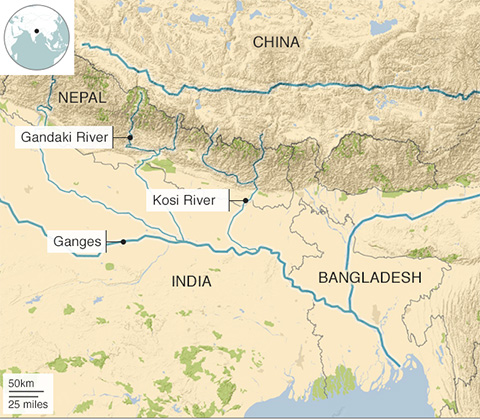Important Facts For Prelims
Dagmara Hydro-Electric Project: Bihar
- 15 Jun 2021
- 3 min read
Why in News
Recently, a Memorandum of Understanding (MoU) has been signed between National Hydro Power Corporation (NHPC) Limited and Bihar State Hydroelectric Power Corporation Limited (BSHPC) for Implementation of Dagmara Hydro-Electric Project, Supaul, Bihar.
- NHPC is a Category-A Miniratna Company under the Ministry of Power, in the field of Hydropower.
- It is the largest organisation for hydropower development in India, currently, NHPC has 24 operational power stations with a total installed capacity of 7071 Mega Watt (MW).
Key Points
- About:
- The project is located near village Dagmara on the right bank and Simri on the left bank, about 22.5 km downstream of Bhimnagar barrage on Kosi river.
- It is a Run-of-the-River scheme. Run-of-river hydro projects use the natural downward flow of rivers and micro turbine generators to capture the kinetic energy carried by water.
- Typically water is taken from the river at a high point and diverted to a channel, pipeline, or pressurised pipeline (or penstock).
- The project will have the total capacity of generating 130 MW energy, in which 17 units of 7.65 MW will be installed for power generation.
- The estimated cost of construction of this project is at Rs. 2478.24 crore.
- Significance:
- It will be a landmark project in the power sector scenario of Bihar as far as green power is concerned.
- Apart from generating clean and green power, the execution will boost the socio-economic and infrastructure development in the area and shall also create employment opportunities.
Kosi River
- The Kosi is a trans-boundary river which flows through Tibet, Nepal and India.
- It has its source in Tibet that includes the world's highest upland; it then drains a large part of Nepal before emerging onto the Gangetic plains.
- Its three major tributaries, the Sun Kosi, Arun and Tamur meet at one point just upstream of a 10 km gorge cut through the Himalayan foothills.
- The river crosses into northern Bihar, India where it branches into distributaries before joining the Ganges near Kursela in Katihar district.
- Its unstable nature has been attributed to course changes and the heavy silt it carries during the monsoon season, and flooding in India has extreme effects.
- The Kosi carries the maximum amount of silt and sand after the Brahmaputra in India.
- It is also known as the “Sorrow of Bihar” as the annual floods affect about 21,000 km2 of fertile agricultural lands thereby disturbing the rural economy.







